It is said that Zhongchuang, which can not sell 30 cups of coffee a day, how is life now?
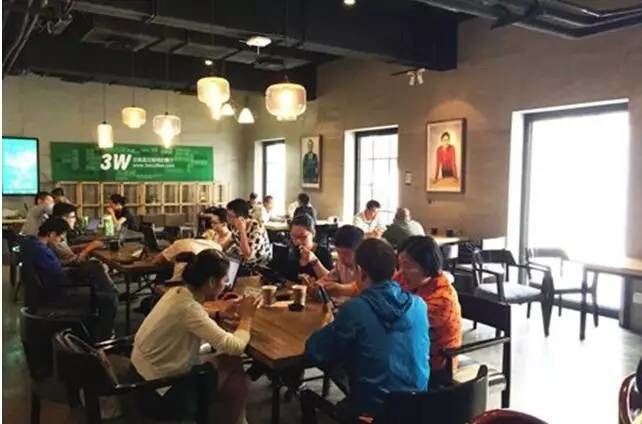
Tencent Venture | ID:qqchuangye
Wen / Tencent Entrepreneurship Manager Mufei
On a rare rainy day in Beijing, there was a lively scene in the 3W cafe on Zhongguancun Entrepreneurship Street: an entrepreneur was talking about his project to the investors opposite him. Words such as "channel sinking" and "consumption trend" came from bits and pieces; on the round table next door to the window, a startup team was brainstorming.
Such a scene reminds people of two years ago. At that time, under the call of "mass entrepreneurship, mass innovation", Internet innovation was booming, the entrepreneurial street was crowded, and the space for mass innovation was blooming everywhere.
However, only a year later, their fate has been dramatically reversed. With the bursting of the entrepreneurial bubble and the arrival of the cold winter of capital, it was exposed that the space for mass innovation, which once claimed to be different, actually lived only by renting workplaces. even, "mass collapse of mass innovation space", "more than half of the mass innovation space is losing money" and other reports are often seen in the press.
What is even more puzzling is that the pace of increasing mass innovation space in various places does not seem to slow down, and many areas even put up the slogan "add XX start-up blocks within a year, and the area of mass innovation space exceeds XX10,000 square meters." For a time, the living condition of Zhongchuang space became complicated and confusing.
In the past week, Tencent Entrepreneurship visited several well-known mass creation spaces and combined with public data to try to restore the truth of the current mass creation space.
The growth of mass innovation space tends to be rational as a whole.
In the past two years, Zhongchuang Space has experienced the development of the "Great Leap forward". According to the 2016 White Paper on the Development of China Mass Creative Space released by Tencent Research Institute, there were less than 50 mass creative spaces in China in 2014, and not long ago, according to Zhang Zhihong, director of the Torch Center of the Ministry of Science and Technology, Xinhua quoted Zhang Zhihong, director of the Ministry of Science and Technology. At present, there are more than 4200 mass creative spaces in the country. It has increased more than 80 times in just two years.
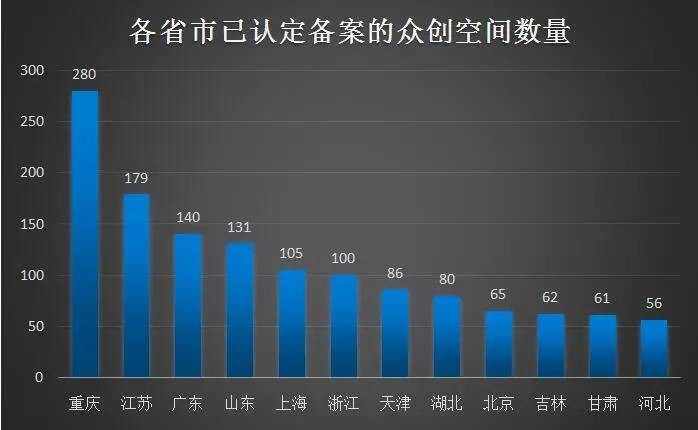
Source: Tencent Research Institute "2016 China Zhongchuang Space Development White Paper"
At the same time, various possible problems in mass creation space have also been exposed: insufficient occupancy rate, single income structure, supporting services into "grocery stores", and so on. These topics are often mixed into fragmented reports, and it is difficult to tell whether they are true or false. We will also sort out these problems one by one in the following carding.
After entering 2017, in response to the State Council's policy of developing mass creative space, various localities have issued plans for the development of mass creative space, but with the exception of individual provinces and cities that plan to add about 5 times the original number of mass creative space, the growth of mass creative space in other areas tends to be rational.
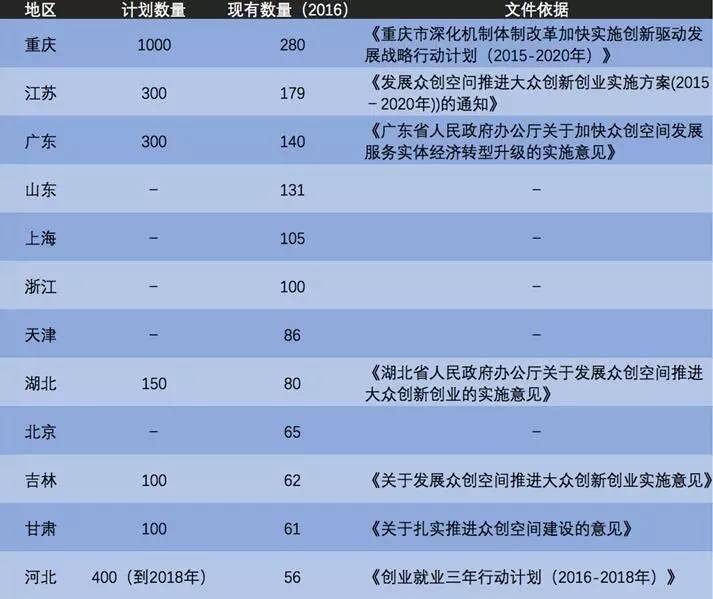
The goal of mass space construction in all provinces and cities by 2020
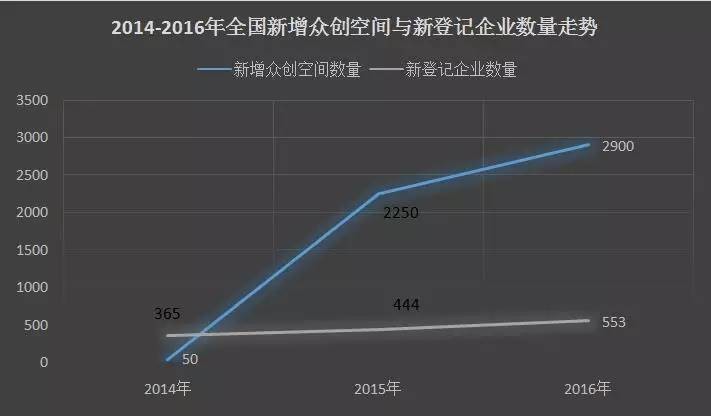
Data sources: general Administration for Industry and Commerce, Xinhuanet, Tencent Research Institute
As can be seen from the above two charts, after the outbreak of 2014-2015, the growth of mass innovation space has slowed down as a whole. In the next four years, the number of mass innovation space in most provinces and cities will only double. For example, the mass innovation space in Jiangsu, Guangdong and Hubei will be expanded from 179, 140 and 80 to 300, 300 and 150 respectively. The growth rate of mass innovation space has gradually moved closer to the growth rate of new enterprises, and it is expected that it will be synchronized in the next four years.
Is it true that the occupancy rate is less than 30%?
In March this year, a report that "mass creation space has become" empty ": the average occupancy rate is only 30%. Some have closed down" caused an uproar, followed by different institutions and media through interviews and other means of survey. throw out 50%, 70%, 85%, and so on. Are these figures really credible? What is the real situation of the mass creation space?
An ordinary working day, Tencent Entrepreneurship walked into the krypton space Zhongguancun shop. There are about 150 workstations, and the open office space is filled with the sound of "crackling" tapping on the keyboard, and occasionally entrepreneurs gather in twos and threes to discuss in a low voice. It was four o'clock in the afternoon, and the occupancy rate of the whole space was about 40%. However, according to the staff, most of the office workers in the space still work in the enterprise, so many people will choose to work in the space after work. Just across the street, another shared office space, 3W Coffee, is already full, but there are only about 20-30 jobs here. Tencent Entrepreneurship found in the interview that the occupancy rate obtained by random sampling like this is very unreliable. The occupancy rate of a space is not only affected by the city, location, scale, peak season and off-season, but also varies greatly at different time points of the day.
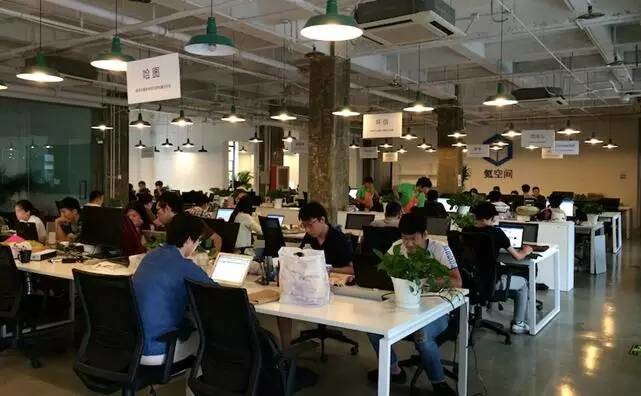
However, the figure of 30% is not without warning. "I think (this number) is quite real," Wan Liushuo, CEO of Unbounded Space, told Tencent Entrepreneurship. "the industry started in 15 years, and everyone entered frantically in 15 and 16 years, and now it has reached the period of integration." He said that in the past two months, six mass creative spaces have found boundless hope to be acquired.
For fledgling players, there are not many opportunities left. "the competitiveness of mass creative space still depends on brands and investment promotion ability," said Wan Liushuo. "there are only a few front-line brands. We will open 20 stores by May, and other brands (the number of stores) are also very close, or even more than us. Therefore, it takes 15-20 for (a fledgling mass-creation space) to be competitive."
The scale effect of big brands is a nightmare for new entrants. This is mainly reflected in two aspects: attracting investment and attracting talents. According to the 2016 Beijing Zhongchuang Blue Book, 74.1% of the mass creative space has a strong demand for high-quality, professional talents, second only to the demand for tax incentives (86.4%) and rent subsidies (82.1%). Even so in the industry as a whole, for the small-scale mass innovation space with weak capital capacity, the lack of talents is a major pain point. Talent and the brand itself affect the rental ability of the space at the same time. Wan Liushuo said that now brands with a single space or only one or two spaces are very short of talents in market operation and investment, coupled with their own background is not ideal enough, the living condition is more worrying.
Can't get rid of the role of "rent collector".
Unlike the occupancy rate, various institutional reports and media reports have surprisingly consistent conclusions on the profitability of mass space-losses. Although the number of profitable mass creation spaces increased in 2016 compared with 2015, 55 percent of the space is still in a state of loss, according to the Blue Book of Beijing Mass Innovation Space. In addition, reports from Beijing, Shanghai, Xiamen and other places also show that more than half of the mass innovation space is in a state of loss.
However, both large and small brands are faced with a common problem in recent years: single revenue structure and high dependence on rental income. According to the 2016 Beijing Mass Creative Space Blue Book (hereinafter referred to as the Blue Book), rent / workplace income accounts for 45.54% of mass creative space income on average.
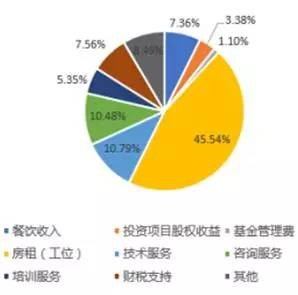
Source: 2016 Beijing Mass creation Space Blue Book
In fact, the space for mass innovation is not without other profit models. At present, in addition to rent, there are generally three sources of income from services, investment and subsidies. Let's look at them separately:
Mediocre performance of service revenue
Nowadays, if you click on any official website of mass creation space, you can see a wide range of entrepreneurial services, but the income from the services has been mediocre.
During the interview, Tencent Entrepreneurship found that at present, the fees charged by Zhongchuang Space for services are mainly divided into two forms: one is to package technology, consulting and other services with property and rent, and the other is to be charged by a third party. by the entrepreneur to coordinate directly with it, the space only plays the role of "matchmaking". Either way of charging seems to show that services have not become an important source of revenue for creative space, or even largely packaged as a concept to attract entrepreneurs.
According to Wan Liushuo, Unbounded adopts a hybrid model, with access to third-party services and services such as headhunting and training provided by the space itself, which accounts for about 5% of the total revenue.
At the same time, more and more space is facing the question of "grocery store". Through the inquiry of public information, we can see that at present, most of the space is mainly to provide comprehensive basic services, such as industrial and commercial registration, legal consultation, financial consultation, etc., which is highly replaceable and easy to become a "grocery store". And tend to be homogenized with competitors.

Most of the services are basic services. The pictures are from WeWork's official website.
In some public reports, we also see a lot of entrepreneurs complaining that they don't have what we want. These entrepreneurs say that space can only provide work stations and some basic services, while others have to fight for on their own, such as financing, the platform is only as an intermediary, and it is still difficult for ordinary entrepreneurs to get investment.
In the process of communicating with a number of entrepreneurs, Tencent Entrepreneurship also found that the original intention of most entrepreneurs to enter the space is to seek resources, training and other services. An entrepreneur who once worked in WeWork in the United States expressed such expectations when comparing the space of mass creation at home and abroad: "entrepreneurs are very hard. How can they help everyone, body and mind, resources, etc.?" As a community manager (community manager), how do you design your performance? Do you know all the member? What do they do, what kind of team, what products, what needs? If you want to lose your mind, take everyone high. "
The return period of investment model is too long.
Recently, investment is also considered to be a possible way to make a profit in the space of mass creation. At present, there are two modes of mass innovation space through investment income, one is equity investment, and mass innovation space provides seed funds for equity investment in incubating enterprises, or through "rent shares, service shares" and other packaged ways to exchange shares; second, project investment, through the specific operation of a project, to share profits.
However, this profit-making approach also faces many challenges. According to the 2016 Mass Innovation Space Research report released by Pudong Innovation Research Institute, the "incubation + investment" model has at least the following problems:
1. In the case of more and more incubation platforms, the scramble for resources also appears, and objectively, the distribution of good projects is more scattered than before, and the cost of the project for investors is getting higher and higher.
two。 The incubation platform bundles the interests of the incubating enterprises through investment, and its long-term income is related to the development success or failure of the invested projects, and the risk is increased.
3. After capital injection, there is a demand for short-term income, which in many cases disturbs and strikes the growth of the project.
According to the blue book, at present, the income from investment accounts for less than 4% of the total income in Beijing. Wan Liushuo also said that the room for investment now is in the single digits.
From the above analysis, Zhongchuang's profit model based on services and investment is not yet mature, perhaps for a long time, Zhongchuang will continue to play the role of "rent collector".
Subsidies used to be "life-saving money", but now they are "chicken ribs"?
Around 2015, it is not surprising that a mass creative space relies on government subsidies to survive. At that time, many media exposed that some space only wanted to enjoy government subsidies first, and whether they could help entrepreneurs or not was not their concern.
However, with the return of entrepreneurship to rationality, the space of mass innovation will eventually have to face the problem of self-hematopoiesis. For the current mass innovation space, which is highly dependent on rent, attracting investment is the primary task. The support from the government lies more in the entrepreneurial environment, which has no substantive effect on investment promotion itself. Once the life-saving money, may inevitably be reduced to chicken ribs.
Feel the stones to cross the river
When talking about the revenue model in which the space of mass creation is slightly single, Liu Min, who has worked in a traditional incubator, said, "it is very confusing for people to create space now." "there are also many people who think that the mass creation space itself is a false proposition."
Wan Liushuo does not agree with this view: "Why is (relying on rent) a problem?" I don't think it's a problem. For example, the Internet is to do traffic, the way we do traffic is to rent out the station, more and more people will come in in the future, and there is more room for imagination. "
Wang Xiaolu also said that rent is the foundation of commercial office real estate operation, almost all joint office space, the main source of income is rent.
However, he added: "the essence of what the dream adds to doing is to change the nature of 'rent'. The logic of our thinking about joint office should be to rely on the intelligent and forward-looking concept of science and technology to upgrade the traditional rental and sale model by area to a service-based management and operation model, that is, from 'paying for area' to 'paying for services'." The service here seems to be understood as an integration of factors of production.
An interesting phenomenon is that although the vast majority of mass space managers are not shy about relying on rent, many people are still eager to distance themselves from the "second landlord". Maybe not many people really want to figure it out.
In any case, a new round of reshuffle is under way, and investors are still optimistic about the strength of the space for mass innovation. In March this year, Unbounded Space announced that it would complete nearly 100 million yuan of A+ round financing in January. For the mass creation space like boundless, groping and moving forward may be the best way out at present. Hope that after the bubble fades, reshuffle and change blood, Zhongchuang space can explore a better way of development.
The above is the survey on the development of mass innovation space brought by Tencent Entrepreneurship.
However, under the call of "mass entrepreneurship, mass innovation", there is not only mass innovation space, but also joint office mode. Since 2015, the number of joint offices has experienced an unstoppable frenzy of growth, but with the arrival of the cold winter of capital, the news of their losses and closures has been coming, and it has been revealed that the average occupancy rate is only 30%.
The mortality rate of startups is so high, is co-working all right?
Apart from entrepreneurs, are there many people who need to rent office space?
Apart from collecting rent, what else can joint offices do to make money?
[insiders of the Entrepreneurship Bureau] invited WeWork founder Mao Daqing, 3W CEO Wang Feiqin, Krypton Space President Zhong Shu, Unbounded Space founder Wan Liu Shuo, Dream Plus Joint Office Space founder Wang Xiaolu and other front-line CEO of venture capital circles to participate in answering questions. They elaborated from different angles:

Important Notice :
前街咖啡 FrontStreet Coffee has moved to new addredd:
FrontStreet Coffee Address: 315,Donghua East Road,GuangZhou
Tel:020 38364473
- Prev

1000 cups! French Paris coffee, unexpectedly parachuted into Garden City?!
What would you do if you stole half a day of floating life? Watch a movie full of stars but full of urine? Or go home and lie down and fall asleep? Think about it carefully, it feels like a waste of life! If they are French, they will probably walk to a nearby cafe, a cup of coffee with an afternoon of sunshine and time, this is a typical French coffee life. Someone put the cafe
- Next

The press conference of the East China Competition of baristas skills was held in Suzhou.
On April 12, the press conference of the 2017 China baristas skills Competition East China Division and the warm pro bono student aid activity to give you a cup of coffee was successfully held in Tongli, Wujiang. Zhou Xianfang, Vice Chairman of Suzhou Federation of Industry and Commerce, and Zhang, Director of Private Education Service Center of Suzhou Bureau of Education
Related
- Is espresso stored overnight in the refrigerator harmful to your body? Is frozen coffee better than freshly ground coffee?
- What parameters and proportions of water temperature should be used to grind and brew fresh coffee beans? Why can't I drink freshly roasted coffee right away?
- Customers have "changed" Manner's new products! Shop assistant: Please don't mess around!
- Remove sockets in customer areas at Starbucks stores?! Netizen: I won't go if I really tear it down
- What is the difference between the taste steps of sun-dried coffee and washed coffee? Why is sun-cured coffee sweeter and washed coffee sour?
- The recipe for salty grapefruit dirty is revealed! Coffee Festival salty grapefruit dirty coffee making materials parameters ratio milk share!
- How about the flavor of Sunlight 74158 at Sidamo Banshaha Mathieu Processing Factory in Ethiopia? 74158 Share the proportion of coffee brewing parameters!
- What effect does Italian American coffee with filter paper have? Will coffee taste better if it is put on filter paper at the bottom of the powder bowl?
- What is the color difference in coffee beans? What are the characteristics of honey processed coffee beans? Why are the anaerobically treated coffee beans uneven in color?
- How does novice Xiaobai quickly get started and make coffee? Newbies learn to make coffee by hand and share the specific steps and process process!

